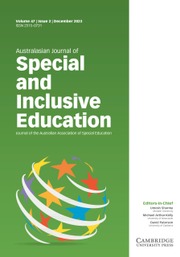Article contents
‘Our Classes Are Like Mainstream School Now’: Implementing Universal Design for Learning at a Special School
Published online by Cambridge University Press: 22 June 2023
Abstract
Students with emotional and behavioural disability who receive their education in special settings often do not have access to the curriculum through evidence-based pedagogies, such as direct instruction, and instead complete packets of worksheets or participate in distance education. The current study was a collaborative action research project involving a special school for students with emotional disability and a local university to examine the effects of replacing online distance education with in-person direct instruction underpinned by Universal Design for Learning. Researchers sought to discover teacher and student perceptions of Universal Design for Learning, enablers and barriers to its implementation, and its effect on attendance and behaviour. Results suggested satisfaction on the part of both students and teachers and a positive effect of Universal Design for Learning on both attendance and behaviour.
Keywords
Information
- Type
- Original Article
- Information
- Australasian Journal of Special and Inclusive Education , Volume 47 , Issue 2 , December 2023 , pp. 63 - 77
- Copyright
- © The Author(s), 2023. Published by Cambridge University Press on behalf of Australian Association of Special Education
Footnotes
This manuscript was accepted under the Editorship of Michael Arthur-Kelly.
References
- 6
- Cited by

